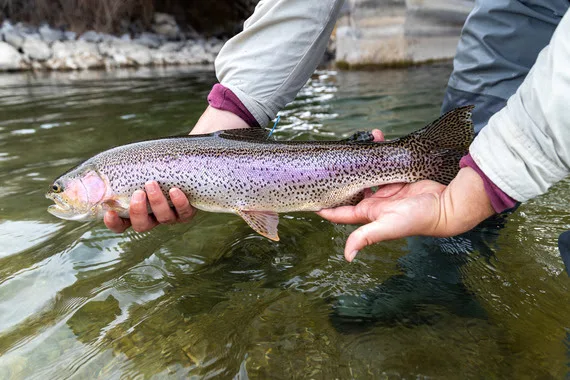Montana Fish, Wildlife & Parks is continuing its focus on trout health and population monitoring in the upper Jefferson River basin as part of a cooperative research effort that began last year.
Trout surveys in 2023 found population estimates to be at or near historical lows in sections of the Big Hole, Beaverhead and Ruby rivers, coupled with observations of sick trout. Since then, FWP has collaborated with Montana State University in three PhD studies looking at causes of mortality for adult trout, how tributaries contribute to mainstem trout populations, and ways to enhance proactive fish health monitoring.
In 2024, fisheries staff found nearly all sampled trout in the basin to be healthy, with less than 1 percent of captured fish showing signs of infection. In the past two years of spring sampling, population estimates have improved in some sections of these rivers, though most remain below average. While river flows are a major contributor to fish health and abundance, the joint research aims to provide better understanding of other potential contributors to population declines.
“We remain committed to managing for a healthy fishery in the upper Jefferson River basin, and these studies will help identify actionable steps for improvement,” said FWP’s Chief of Conservation Policy, Quentin Kujala. “We appreciate anglers’ contributions to this important research.”
As part of this effort, FWP will continue to share results from annual spring population sampling, as well as other findings as they become available. Interim reports on the three MSU studies can be found on FWP’s website.
2025 spring sampling
Trout surveys in the basin this spring showed continued trout population improvements in some mainstem sections, while other areas indicate trout abundances lower than those observed in 2024.
Estimates for 2025 show increases from 2024 estimates for brown trout in all sampling sections of the Beaverhead River. While some sections of the Big Hole and Ruby increased from last year, estimates in nearly all sections remain below long-term averages for both brown and rainbow trout. Despite low flows and warm water temperatures throughout much of the region last summer, a relatively strong cohort from 2023 appears to have stabilized many populations for now.
“Although spring estimates are encouraging in places like the Beaverhead River, there’s still work to be done in other areas, and we need to remain vigilant in our efforts to improve conditions, even where rainbow and brown trout populations have rebounded the last several years,” said FWP’s Fisheries Program Manager in southwestern Montana, Mike Duncan.
Collaborative research
FWP and MSU are in the second year of collaborative research to better understand the major limiting factors contributing to the trout declines in the upper Jefferson Basin. The MSU projects, coupled with other research aimed at forecasting future abundances based on juvenile trout recruitment, will allow FWP and partners to take a much more proactive approach to supporting those popular fisheries as well as providing the public with a better idea of what expect for the coming fishing season.
This spring, FWP staff continued tagging fish in parts of the Big Hole, Beaverhead, Ruby and Madison rivers. When anglers report each tagged fish they catch, they’re substantively contributing to the informed management of these fisheries by helping researchers identify individual fish and monitor their health, survival, movement and other indicators over time.
FWP and MSU have been working with Montana Trout Unlimited to host drawings for guided fishing trips, equipment and other prizes for anglers who have submitted reports of catching tagged fish. Some anglers also received cash rewards. These reward opportunities will continue for anglers who submit reports of tagged fish.
To learn more about the research effort and how to report a tagged fish, click here.

-fwp-



